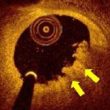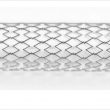Most acute coronary syndromes (ACS) are caused by the following three different pathologies: Plaque rupture Plaque erosion Calcified nodule In daily clinical practice, all patients who experience them are treated with angioplasty, regardless of which of these physiopathologies led to the ACS in each case. Some early reports indicate that patients with plaque erosion might...
Efficacy of Micromesh-Covered Stents in Carotid Artery Stenting
Most literature, old and recent, associates carotid artery stenting with a higher rate of stroke (although minor) when compared with carotid endarterectomy during the acute period. However, 30-day outcomes of angioplasty and surgery are comparable. Many technical advancements, including new stent designs and different cerebral protection mechanisms, have improved the outcomes of angioplasty in clinical...
DARE: Drug-Coated Balloons Compete with DES for the Treatment of In-Stent Restenosis
Courtesy of the Brazilian Society of Hemodynamics and Interventional Cardiology (SBHCI). The SeQuent Please paclitaxel-coated balloon provides non-inferior angiographic results when compared with the Xience everolimus-eluting stent for the treatment of in-stent restenosis. At 6 months, the minimal lumen diameter was 1.71 mm in the drug-coated balloon arm and 1.74 mm in the Xience arm, a difference that...
Excellent Outcomes for the First Sirolimus Eluting Balloon Tested on Instent Restesosis
Much has been done since studies on conventional balloon angioplasty for BMS instent restenosis showed over 40% new revascularization. Drug eluting stents, aimed at improving this problem, have never achieved 0% restenosis, which is why technologies such as paclitaxel coated balloons have been developed, with reasonable efficacy (8% to 10% reinterventions rate for BMS restenosis and 17% to 23%...
Endarterectomy vs. Stenting in Asymptomatic Carotid Artery Stenosis
The comparative efficacy and safety of carotid stenting vs. endarterectomy in asymptomatic carotid stenosis patients remains controversial and, what is worse, consensus seems unlikely in the near future. Given the lack of definite evidence, several meta-analyzis and systematic reviews have been produced in an attempt to shed some light on this matter. This study included all...
SYNTAX II: Better Stents, IVUS, FFR, or a Combination of All of Them to Catch Up with Surgery
In patients with 3-vessel disease, surgery obtained better outcomes than angioplasty, according to results from the SYNTAX and FREEDOM trials, which used first-generation drug-eluting stents. Even in the BEST trial, which used new-generation stents, surgery still offered far better outcomes. Nobody is surprised by the fact that, whenever angioplasty evolves due to a new device...
Self-Expanding Stents Are Superior to Balloon-Expandable Stents in the Iliac Arteries
Courtesy of Dr. Carlos Fava. Severe atherosclerotic disease in iliac arteries is experienced by 15% of all men and 5% of all women. TAC II recommends angioplasty for type-A, -B, and -C lesions. As regards stent type, self-expanding stent (SE, more elasticity) vs. balloon-expandable stent (SB, more radial strength), Reekers indicates superior target lesion revascularization (TLR) with SE. However, there...
Are Bioresorbable-Polymer Stents More Thrombogenic than Durable-Polymer Second-Generation Stents?
Courtesy of Dr. Cristian Jesús Rodríguez. Most stents currently used in percutaneous coronary intervention (PCI) are durable-polymer second-generation drug-eluting stents (DP-DES, with everolimus or zotarolimus). However, it has been argued that the persistence of such a polymer after complete drug elution is one of the main factors for a dangerous complication: stent thrombosis (ST). After...
Statin Pre-Treatment for the Prevention of Peri-Procedural Events in Carotid Artery Stenting
Recent randomized studies have shown that the rates of combined peri-procedural events for carotid artery stenting and carotid endarterectomy are similar. While the final numbers are similar, the actual events are different: more infarction events for endarterectomy and more stroke (particularly minor stroke) events for carotid artery stenting. The reduction of these rates of stroke has been the aim of...
Protection Systems Reduce Stroke and Mortality in Carotid Artery Stenting
So far, the main controlled randomized studies have almost exclusively been aimed at comparing the efficacy and safety of carotid artery stenting vs. endarterectomy. Almost all of them have left at operator discretion the choice of the devices to be used during the procedure, which is why there is few direct information to help us...









